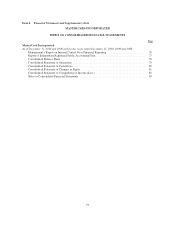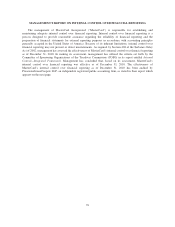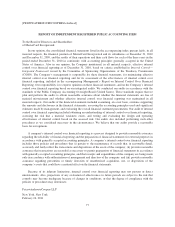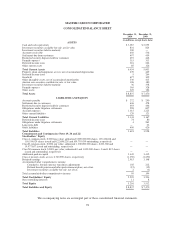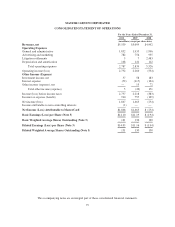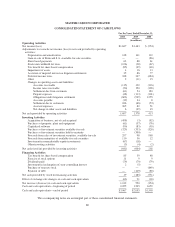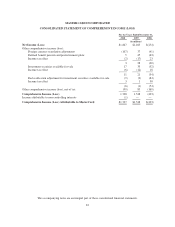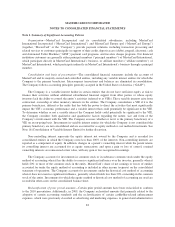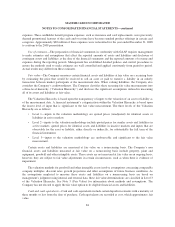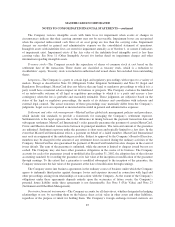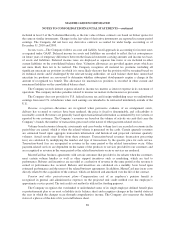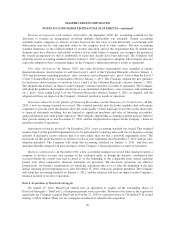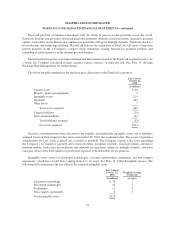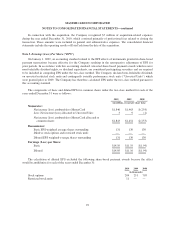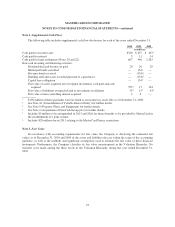MasterCard 2010 Annual Report Download - page 93
Download and view the complete annual report
Please find page 93 of the 2010 MasterCard annual report below. You can navigate through the pages in the report by either clicking on the pages listed below, or by using the keyword search tool below to find specific information within the annual report.MASTERCARD INCORPORATED
NOTES TO CONSOLIDATED FINANCIAL STATEMENTS
Note 1. Summary of Significant Accounting Policies
Organization—MasterCard Incorporated and its consolidated subsidiaries, including MasterCard
International Incorporated (“MasterCard International”) and MasterCard Europe sprl (“MasterCard Europe”)
(together, “MasterCard” or the “Company”), provide payment solutions, including transaction processing and
related services to customers principally in support of their credit, deposit access (debit), prepaid, electronic cash
and Automated Teller Machine (“ATM”) payment card programs, and travelers cheque programs. Our financial
institution customers are generally either principal members (“principal members”) of MasterCard International,
which participate directly in MasterCard International’s business, or affiliate members (“affiliate members”) of
MasterCard International, which participate indirectly in MasterCard International’s business through a principal
member.
Consolidation and basis of presentation—The consolidated financial statements include the accounts of
MasterCard and its majority-owned and controlled entities, including any variable interest entities for which the
Company is the primary beneficiary. Intercompany transactions and balances are eliminated in consolidation.
The Company follows accounting principles generally accepted in the United States of America (“GAAP”).
The Company is a variable interest holder in certain entities that do not have sufficient equity at risk to
finance their activities without additional subordinated financial support from other parties or whose equity
investors lack the ability to control the entity’s activities (referred to as VIEs). These variable interests arise from
contractual, ownership or other monetary interests in the entities. The Company consolidates a VIE if it is the
primary beneficiary, defined as the entity that has both the power to direct the activities that most significantly
impact the VIE’s economic performance and a variable interest that could potentially be significant to the VIE.
To determine whether or not a variable interest the Company holds could potentially be significant to the VIE,
the Company considers both qualitative and quantitative factors regarding the nature, size and form of the
Company’s involvement with the VIE. The Company assesses whether or not it is the primary beneficiary of a
VIE on an on-going basis. Investments in variable interest entities for which the Company is not considered the
primary beneficiary are not consolidated and are accounted for as equity method or cost method investments. See
Note 16 (Consolidation of Variable Interest Entity) for further discussion.
Non-controlling interest represents the equity interest not owned by the Company and is recorded for
consolidated entities in which the Company owns less than 100% of the interests. Non-controlling interests are
reported as a component of equity. In addition, changes in a parent’s ownership interest while the parent retains
its controlling interest are accounted for as equity transactions, and upon a gain or loss of control, retained
ownership interests are remeasured at fair value, with any gain or loss recognized in earnings.
The Company accounts for investments in common stock or in-substance common stock under the equity
method of accounting when it has the ability to exercise significant influence over the investee, generally when it
holds 20% or more of the common stock in the entity. MasterCard’s share of net earnings or losses of entities
accounted for under the equity method of accounting is included in other income (expense) on the consolidated
statement of operations. The Company accounts for investments under the historical cost method of accounting
when it does not exercise significant influence, generally when it holds less than 20% ownership in the common
stock of the entity. Investments for which the equity method or historical cost method of accounting are used are
recorded in other assets on the consolidated balance sheet.
Reclassification of prior period amounts—Certain prior period amounts have been reclassified to conform
to the 2010 presentation. Additionally, in 2009, the Company reclassified amounts that primarily related to the
adoption of certain accounting standards and the reclassification of certain cardholder-related enhancement
expenses, which were previously classified as advertising and marketing expenses, to general and administrative
83




